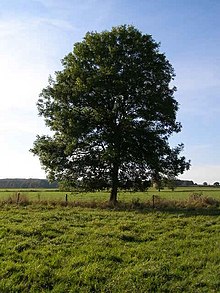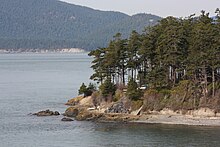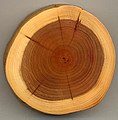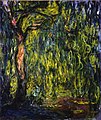Portal:Trees
The Trees Portal

In botany, a tree is a perennial plant with an elongated stem, or trunk, usually supporting branches and leaves. In some usages, the definition of a tree may be narrower, including only woody plants with secondary growth, plants that are usable as lumber or plants above a specified height. In wider definitions, the taller palms, tree ferns, bananas, and bamboos are also trees.
Trees are not a monophyletic taxonomic group but consist of a wide variety of plant species that have independently evolved a trunk and branches as a way to tower above other plants to compete for sunlight. The majority of tree species are angiosperms or hardwoods; of the rest, many are gymnosperms or softwoods. Trees tend to be long-lived, some reaching several thousand years old. Trees have been in existence for 370 million years. It is estimated that there are around three trillion mature trees in the world.
A tree typically has many secondary branches supported clear of the ground by the trunk, which typically contains woody tissue for strength, and vascular tissue to carry materials from one part of the tree to another. For most trees it is surrounded by a layer of bark which serves as a protective barrier. Below the ground, the roots branch and spread out widely; they serve to anchor the tree and extract moisture and nutrients from the soil. Above ground, the branches divide into smaller branches and shoots. The shoots typically bear leaves, which capture light energy and convert it into sugars by photosynthesis, providing the food for the tree's growth and development.
Trees usually reproduce using seeds. Flowers and fruit may be present, but some trees, such as conifers, instead have pollen cones and seed cones. Palms, bananas, and bamboos also produce seeds, but tree ferns produce spores instead.
Trees play a significant role in reducing erosion and moderating the climate. They remove carbon dioxide from the atmosphere and store large quantities of carbon in their tissues. Trees and forests provide a habitat for many species of animals and plants. Tropical rainforests are among the most biodiverse habitats in the world. Trees provide shade and shelter, timber for construction, fuel for cooking and heating, and fruit for food as well as having many other uses. In much of the world, forests are shrinking as trees are cleared to increase the amount of land available for agriculture. Because of their longevity and usefulness, trees have always been revered, with sacred groves in various cultures, and they play a role in many of the world's mythologies. (Full article...)

Betula pubescens (syn. Betula alba), commonly known as downy birch and also as moor birch, white birch, European white birch or hairy birch, is a species of deciduous tree, native and abundant throughout northern Europe and northern Asia, growing farther north than any other broadleaf tree. It is closely related to, and often confused with, the silver birch (B. pendula), but grows in wetter places with heavier soils and poorer drainage; smaller trees can also be confused with the dwarf birch (B. nana).
Six varieties are recognised and it hybridises with the silver and dwarf birches. A number of cultivars have been developed but many are no longer in cultivation. The larva of the autumnal moth (Epirrita autumnata) feeds on the foliage and in some years, large areas of birch forest can be defoliated by this insect. Many fungi are associated with the tree and certain pathogenic fungi are the causal agents of birch dieback disease. (Full article...)Did you know? -
- ... that a fellow artist said of Allen Butler Talcott that "no one was his peer in the knowledge of trees and how to paint them" (painting of oak pictured)?
- ... that sex scenes in the controversial 1967 film I Am Curious (Yellow) were shot inside the Rumskulla oak, an oak tree that is more than 1,000 years old?
- ... that the red nose-like structure of the cherrynose cicada contains muscles that help it suck xylem out of trees?
- ... that extracts from leaves of the mahogany tree suren toon are used as antibacterial poultices?
- ... that The Greening of Detroit has planted over 81,000 trees in the Michigan city since the organization's inception in 1989?
- ... that the vinhática tree, Plathymenia reticulata (pictured), provides the preferred timber for making dugout canoes in Brazil, because it is resistant to rotting?
Selected article -

The Douglas fir (Pseudotsuga menziesii) is an evergreen conifer species in the pine family, Pinaceae. It is native to western North America and is also known as Douglas-fir, Douglas spruce, Oregon pine, and Columbian pine. There are three varieties: coast Douglas-fir (P. menziesii var. menziesii), Rocky Mountain Douglas-fir (P. menziesii var. glauca) and Mexican Douglas-fir (P. menziesii var. lindleyana).
Despite its common names, it is not a true fir (genus Abies), spruce (genus Picea), or pine (genus Pinus). It is also not a hemlock; the genus name Pseudotsuga means "false hemlock". (Full article...)General images
-
Forest in the Scottish Highlands (from Forest)
-
Selling firewood at a market (from Tree)
-
Tall herbaceous monocotyledonous plants such as banana lack secondary growth, but are trees under the broadest definition. (from Tree)
-
Proportion and distribution of global forest area by climatic domain, 2020 (from Forest)
-
People trees, by Pooktre (from Tree)
-
World production of selected forest products (from Forest)
-
Spiny forest at Ifaty, Madagascar, featuring various Adansonia (baobab) species, Alluaudia procera (Madagascar ocotillo) and other vegetation (from Forest)
-
Buds, leaves and reproductive structures of white fir (Abies alba) (from Tree)
-
Proportion of forest in protected areas, by region, 2020 (from Forest)
-
The General Sherman Tree, thought to be the world's largest by volume (from Tree)
-
Northern beech (Fagus sylvatica) trunk in autumn (from Tree)
-
Conifers in the Swabian alps (from Tree)
-
4000 years old Cypress of Abarqu is the oldest tree in Iran and the second oldest tree in the world. (from List of trees of Iran)
-
Roof trusses made from softwood (from Tree)
-
The Amazon rainforest alongside the Solimões River, a tropical rainforest. These forests are the most biodiverse and productive ecosystems in the world. (from Forest)
-
Olive trees in Pakistan (from Trees of Pakistan)
-
Buds, leaves, flowers and fruit of oak (Quercus robur) (from Tree)
-
Diagram of secondary growth in a eudicot or coniferous tree showing idealised vertical and horizontal sections. A new layer of wood is added in each growing season, thickening the stem, existing branches and roots. (from Tree)
-
Share of forest area in total land area, top countries (2021) (from Forest)
-
Priest River winding through Whitetail Butte with lots of forestry to the east—these lot patterns have existed since the mid-19th century. The white patches reflect areas with younger, smaller trees, where winter snow cover shows up brightly to the astronauts. Dark green-brown squares are parcels (from Forest)
-
The Daintree Rainforest (from Tree)
-
Rowan tree in Wicklow, Ireland (from List of trees of Great Britain and Ireland)
-
Recently stripped cork oak (Quercus suber) (from Tree)
-
Since the 13th century, the Niepołomice Forest in Poland has had special use and protection. In this view from space, different coloration can indicate different functions. (from Forest)
-
Share of land that is covered by forest (from Forest)
-
Neem tree at Sant Nenuram Ashram (from Trees of Pakistan)
-
Form, leaves and reproductive structures of queen sago (Cycas circinalis) (from Tree)
-
Even, dense old-growth stand of beech trees (Fagus sylvatica) prepared to be regenerated by their saplings in the understory, in the Brussels part of the Sonian Forest. (from Forest)
-
Buttress roots of the kapok tree (Ceiba pentandra) (from Tree)
Selected lists
Subcategories
Related portals
Associated Wikimedia
The following Wikimedia Foundation sister projects provide more on this subject:
-
Commons
Free media repository -
Wikibooks
Free textbooks and manuals -
Wikidata
Free knowledge base -
Wikinews
Free-content news -
Wikiquote
Collection of quotations -
Wikisource
Free-content library -
Wikispecies
Directory of species -
Wikiversity
Free learning tools -
Wiktionary
Dictionary and thesaurus














































































